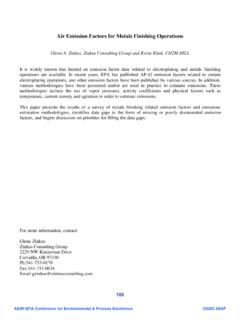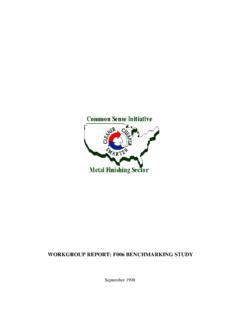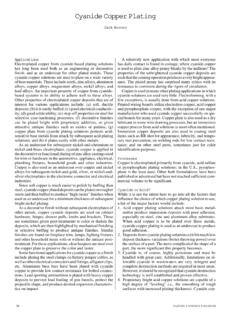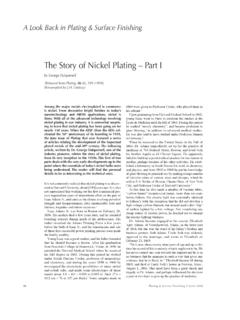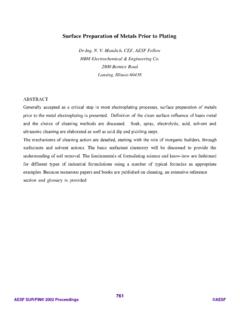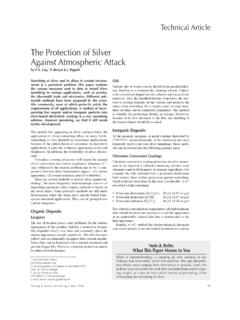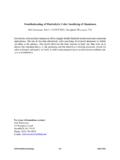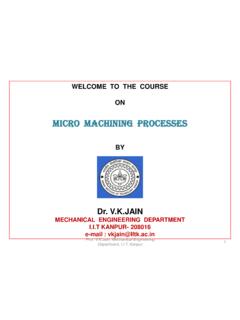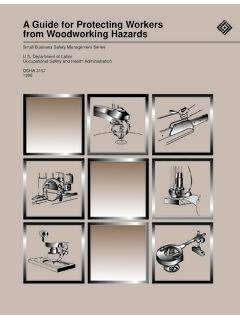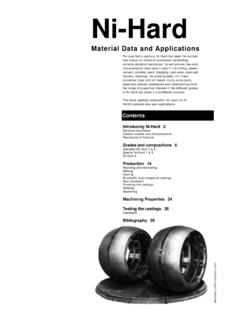Transcription of Electroless Copper Plating A Review: Part I
1 Electroless , or autocatalytic, metal Plating is a non-electrolytic method of deposition from solution. Theminimum necessary components of an electrolessplating solution are a metal salt and an appropriatereducing agent. An additional requirement is that thesolution, although thermodynamically unstable, isstable in practice until a suitable catalyzed surface isintroduced. Plating is then initiated upon the catalyzedsurface, and the Plating reaction is sustained by thecatalytic nature of the plated metal surface itself. Thisdefinition of Electroless Plating eliminates both thosesolutions that spontaneously plate on all surfaces( homogeneous chemical reduction ), such as silvermirroring solutions; also immersion Plating solu-tions, which deposit by displacement a very thin film ofa relatively noble metal onto the surface of a sacrificial,less noble history of Electroless Plating began with the serendipi-tous discovery, by Brenner and Riddell, of Electroless nickel-phosphorus, during a series of nickel electroplating experi-ments in Electroless Copper chemistry was first re-ported in the following year by The first commercialapplication of Electroless Copper was reported in the mid-1950s with the development of Plating solutions for plated-through-hole (PTH) printed wiring boards.
2 Electroless cop-per solutions resembling today s technology were first re-ported in 1957 by Cahill3 with the report of alkaline coppertartrate baths utilizing formaldehyde as reducing agent. Cop-per baths of the 1950s were difficult to control and verysusceptible to spontaneous decomposition. Over the years,continual advances in control and capabilities have takenplace and continue to be recorded in a variety of ,5 Atpresent, not only are formulations extremely stable andpredictable in behavior over long periods and under a widevariety of operating conditions, they also provide copperdeposits having excellent physical and metallurgical proper-ties comparable with electrolytic Copper plates much more slowly, and is a muchmore expensive process, than electrolytic Copper Copper Plating , however, offers advantages overelectrolytic Plating that make it the method of choice incertain cases. Electroless Copper plates uniformly over allsurfaces, regardless of size and shape, demonstrating 100percent throwing power; it may be plated onto non-conduc-tors, or conductive surfaces that do not share electricalcontinuity.
3 The ability to plate large racks of substratessimultaneously is also an advantage in certain advantages have contributed to the choice of electro-less Copper in the applications to be ChemistryThe theoretical basis of the Electroless Copper depositionprocess has been studied on numerous occasions and hasrecently been As stated earlier, the minimumnecessary components of an electro-less Plating solution are the metal saltand a reducing agent. The source ofcopper is a simple cupric salt, such ascopper sulfate, chloride or common reducing agentshave been suggested7 for use in elec-troless Copper baths, namely formal-dehyde, dimethylamine borane, boro-hydride, hypophosphite,8 hydrazine,sugars (sucrose, glucose, etc.), anddithionite. In practice, however, vir-tually all commercial Electroless cop-per solutions have utilized formalde-hyde as reducing agent. This is aresult of the combination of cost,effectiveness, and ease of control offormaldehyde systems, and is par-ticularly remarkable in view of theconsiderable and continual pressuresexerted on the Plating industry byenvironmental and regulatory agen-cies because of health concerns re-garding formaldehyde exposure.
4 Inview of their predominant commer-cial importance, the discussion willbe confined to Copper (II), the relevant half-cell reaction for electro-less deposition is:Cu+2 + 2e- Cu E = + VFor formaldehyde, E depends on the pH of the solution:HCOOH + 2H+ + 2e- HCHO + H2O (pH = 0, E = + )HCOO- + 2H2 + 2e- HCHO + 3OH- (pH = 14, E = )Therefore, Electroless Copper solutions, utilizing formalde-hyde as reducing agent, employ high pH, above 12 (typicalNaOH concentration is > N; theoretically N = pH 13).Because simple Copper salts are insoluble at pH aboveabout 4, the use of alkaline Plating media necessitates use ofa complexing, or chelating, component. Historically,complexing agents for Electroless Copper baths have almostalways fallen into one of the following groups of compounds:1. Tartrate salts2. Alkanol amines, such as quadrol (N,N,N',N'tetrakis(2-hydroxypropyl)ethyl enediamine) or related compounds3. EDTA (ethylenediamine tetraacetic acid) or related com-poundsGlycolic acids and other amines have also been Copper PlatingA Review: Part IBy Cheryl A.
5 DeckertFig. 1 Through-hole,plated using full-buildelectroless & SURFACE FINISHINGT artrates were used in the earliest baths, and continue to beused, particularly for low Plating rate ( m/20 min), low-temperature (near ambient) applications. Tartrates are moreeasily waste-treatable than the other two classes of chelates,but have not readily lent themselves to formulation of fasterplating amines came into wide use in Electroless Cu bathsin the late 1960s, with the advent of faster Plating type of chelate made it possible to achieve high build ( 2 m/20 min) Electroless Copper solutions, and continuesto have wide use even today. Since quadrol and its analogs areliquids, totally miscible with water, they are not easily re-moved from the waste solution; accordingly, they are resis-tant to many conventional waste treatment salts are also widely used for complexing electro-less Copper solutions. EDTA has certain desirable character-istics vs. quadrol, based on waste treatability; specifically,EDTA can be more easily separated (precipitated) fromwaste solutions by pH adjustment.
6 Starting in the late 1970s,bath additives for EDTA systems were developed that al-lowed excellent control of Plating rate, grain structure, andother important factors. Because of the very high affinity ofEDTA for any metal ions, even small residual amounts ofdissolved EDTA can draw potentially toxic metals into thewaste stream. This has led to increased legislative efforts(notably in Germany and Japan) against use of this chelateand its derivatives. At present, however, the most commonlyused Plating baths are based on addition to the Copper salt, reducing agent, source ofalkalinity, and chelate, other important components are presentin commercial Electroless Copper solutions. These compo-nents are generally considered the proprietary portion of theformulation, and control such parameters as initiation andplating rate, stability (vs. dragged-in catalyst; vs. excessivelyhigh bath activity; vs. long shutdown periods; vs. Cu(I)oxide), deposit stress, color, ductility, etc.
7 Prior to develop-ment of well-characterized and controlled trace additives, Electroless Copper baths were prone to triggering (sponta-neous decomposition of the bath), plate-out (decomposi-tion over a prolonged standing period), second-day start-up (inability to induce a controlled Plating reaction whenfirst stored after make-up), dark deposit color, rough deposit,coarse grain structure, and other undesirable hundreds of papers and patents have been publishedrelating to these additives. Useful summaries of these data ,10 Additives that stabilize the bath against various manifesta-tions of undesired plate-out are referred to as stabilizers;understanding their composition, mechanism, and optimalreplenishment rate is key to successful operation of a are usually employed at low concentrations, typicallyone to 100 ppm. Principal among the materials reported arecompounds such as mercaptobenzothiazole, thiourea, othersulfur compounds, cyanide or ferrocyanide salts, mercurycompounds, molybdenum and tungsten, heterocyclic nitro-gen compounds, methyl butynol, propionitrile, etc.
8 Pressurefrom environmental and regulatory groups over the years hasled to near elimination of cyanide and mercury types ofadditives. It is noteworthy that perhaps the most commonstabilizer for Electroless Copper baths is a steady stream of air( , oxygen) bubbled through the that increase the Plating rate of the solution arevariously referred to as rate promoters, rate enhancers,exaltants, or accelerators. This last term is particularly unfor-tunate and confusing in view of the use of the term accelera-tor as a key process step in Electroless Copper that have been reported to function as rate promot-ers include ammonium salts, nitrates, chlorides, chlorates,Fig. 2 Examples of commercially produced molded interconnectdevices. (Courtesy of J. Rychwalski, Shipley Co.)Table 1 Examples of Electroless Copper FormulationsLow Build High Build High Build Full Build(Tartrate) (Quadrol)(EDTA)(EDTA) Copper saltas Cu(II) MChelateRochelle salt Quadrol Disodium EDTA dihydrate25 g/L13 g/L30 g/L42 MFormaldehyde10 g/L3 g/L3 g/Las HCHOA lkalinity5 g/L8 g/L7 g/L3 g/Las NaOHAdditives*<2 g/L<2 g/L<2 g/L<2 g/LTemperature20434570 CPlating m/20 min*Examples of additives: 2-mercaptobenzothiazole, diethyldithiocarbamate,2,2'-dipyridyl, potassium ferrocyanide, vanadium pentoxide, nickel chlo-ride, polyethylene glycolFebruary 199549perchlorates, molybdates and tungstates.
9 Rate promotersmay be present in the Electroless formulation at concentra-tions of M or additives may also be incorporated in certain example, surfactants may be used to improve depositcharacteristics;11 incorporation of excess halide ion into theformulation permits elimination of the normal Typical examples of freshly made-up Electroless cop-per baths are given in Table overall Electroless Copper Plating reaction is theoreti-cally given as:Cu+2 + 2 HCHO + 4 OH- Cu + H2 + 2H2O + 2 HCO2-This equation calls for consumption of four hydroxyl ionsand two molecules of formaldehyde for each atom of copperdeposited. Certain side reactions may also take place, how-ever, the most common being the Cannizzaro reaction, whichconsumes additional caustic and formaldehyde:2 HCHO + OH- CH3OH + HCOO-In addition, other side reactions also occur, consuming form-aldehyde and producing unwanted byproducts, such as cu-prous oxide, which can lead to bath decomposition unlesssuitable stabilizers are use of the bath begins, Copper , caustic and formalde-hyde are consumed and must be replenished.
10 This is typicallycarried out by routine analysis, either manually or electroni-cally, with back addition of appropriate replenishment chem-istries. Ordinarily, some bailing of the Plating solution mustbe done at this point, to allow for the volume of newchemicals to be added. Because the anion of the Copper salt(usually sulfate or chloride), and the cation of the causticcomponent (usually sodium) are not consumed, a build-up ofsodium sulfate or chloride occurs, which can cause deleteri-ous effects, such as voiding or high deposit stress overprolonged bath life, particularly when bailed volumes arevery low. In addition, formate ion builds up as a by-productof the Plating reaction itself. The extent to which theCannizzaro reaction takes place also contributes to the quan-tity of by-product build-up. By-product build-up can causedeterioration of bath and deposit properties,13,14 and is nowtypically accounted for during bath formulation.
